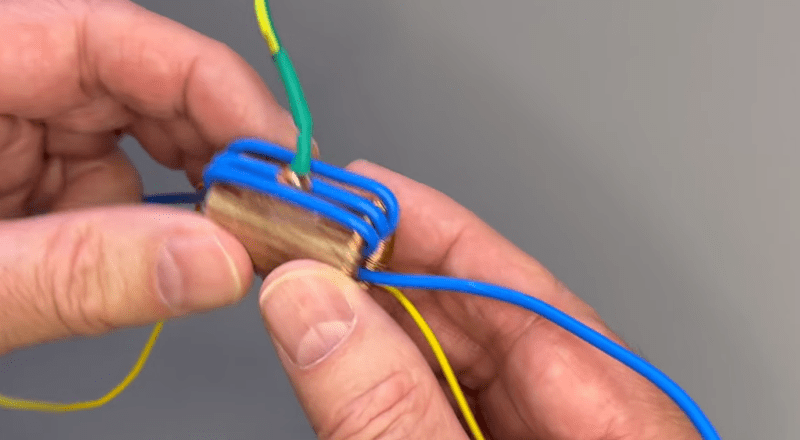Using digital techniques has caused a resurgence of interest in VLF — very low frequency — radio. Thanks to software-defined radio, you no longer need huge coils. However, you still need a suitable antenna. [Electronics Unmessed] has been experimenting and asks the question: What really matters when it comes to VLF loops? The answer he found is in the video below.
This isn’t the first video about the topic he’s made, but it covers new ground about what changes make the most impact on received signals. You can see via graphs how everything changes performance. There are several parameters varied, including different types of ferrite, various numbers of loops in the antenna, and wire diameter. Don’t miss the comment section, either, where some viewers have suggested other parameters that might warrant experimentation.
Don’t miss the 9-foot square antenna loop in the video. We’d like to see it suspended in the air. Probably not a good way to ingratiate yourself with your neighbors, though.
Between software-defined radio and robust computer simulation, there’s never been a better time to experiment with antennas and radios. We first saw these antennas in an earlier post. VLF sure is easier than it used to be.
















I put a 1200 ft coaxial beverage on the top of a cow fence. I didn’t even need a receiver, I could see all of the VLF stations worldwide on my spectrum analyzer.
You didn’t. You saw sources of interference, harmonics and intermodulation signals in the VLF range. And unless you have an SA that costs house money you can’t set the resolution bandwidth narrow enough so you can see signals that a receiver can hear.
VLF is 3 kHz to 30 kHz, only slightly exceeding the range normally considered audio. This is the sort of job that could be handled by an audio spectrum analyzer. General Radio made them more than 55 years ago; there was one in the introductory electronics lab at MIT circa 1968. The output device was a chart recorder.
Audio Precision makes audio test devices for both production and research purposes that are overkill for just seeing what signals are floating about the atmosphere, even their prices are in the $20,000 range, not “house money.”
Although only good up to 22 kHz, the audio input of many computers will provide an SNR of about 96 dB, and an FFT will give any desired frequency resolution.
Today, making a spectrum analyzer for use up to 30 kHz, with a resolution bandwidth below 1 Hz and a dynamic range of 100 dB, is within the capabilities of a good audio engineer and probably within the capabilities of a talented amateur. The heart of such a machine might be a Texas Instruments ADS127L21. At such low frequencies work is just not difficult.
Want more dynamic range without spending heaps of money? If you can wait a minute or so for an output, complex designs involving swept frequencies, modulators, and filters are possible. This is the technique use by GR at least since 1933.
The neighbors only whine about visible antennas if their tv reception is messed up and that is nigh impossible in todays CATV areas
Wanna bet? I used to run a 10m propagation beacon, and because the local cable company (1) had leaky coax strung around the neighborhood, and (2) was improperly using 10m channels to control cable boxes, I was randomly changing channels on folks’ TVs all over the neighborhood.
What is your call? Best 73 de VA3ROD in Toronto Canada
Funny anecdote; the day after I put up my tower and antennas, the neighbours came knocking to complain about interference to their TV. The antenna’s weren’t even hooked up to anything yet. 2 weeks later I installed a plastic owl in the tower to discourage birds from landing on the antennas and making a mess below. The neighbours called animal rescue to rescue the owl that has been sitting there for days. Gotta love people sometimes.
Good reason to live rural. Cuts down on the NIMBY.
Funny Anecdote #2 (IIRC)–
In the mid-1950s or so, the USAF was to start testing >Mach1 aircraft flights in relatively populated areas. This can, of course, create damage on the ground due to the accompanying ‘sonic boom’.
They (it) advertised the fact in local media, and–being good citizens–also advertised (with telephone number) that a special department was being set up to handle any damage claims, such a broken windows, should any arise.
Sure enough, a lady calls the number to report that her very large, very expensive plate glass window has been shattered due to a sonic boom.
AF person (on phone): “Ma’am, those tests don’t start for another two weeks.”.
Complainant: “I’ll call back.”
Add to this the so many on the right hand side of the bell curve who have never been taught the learned skill of critical thought and analysis:
“Think of how stupid the average person is, and realize half of them are stupider than that.” – George Carlin, referring to the IQ bell curve
Love it! When did George Carlin say that? A classic!
They do this with cell towers pretty regularly. Put up the tower and leave it disconnected for a few months to give the locals time to call and complain that it is giving them headaches, making them sick, caused their cancer, activated their vaccine nanochips, etc.
Don’t actually turn on the tower until folks have gotten used to it and stopped blaming everything on it.